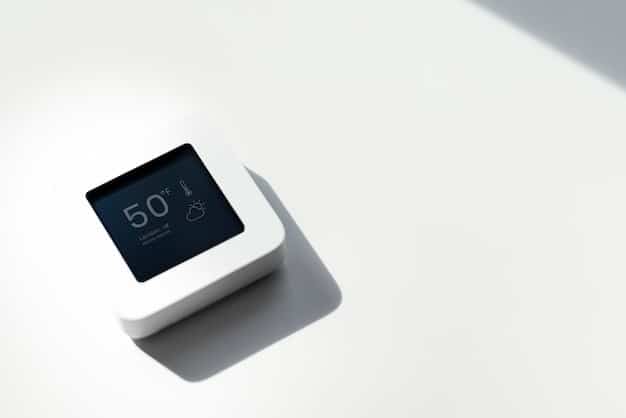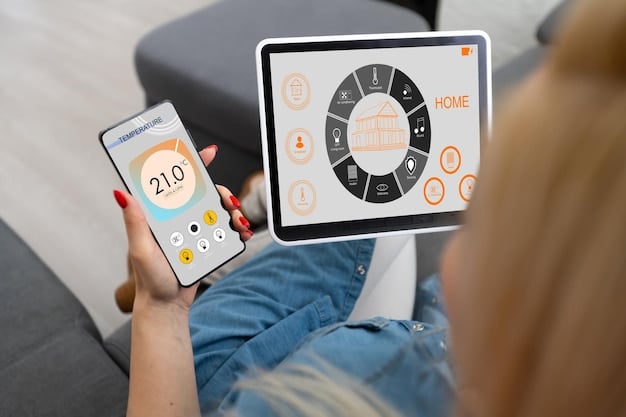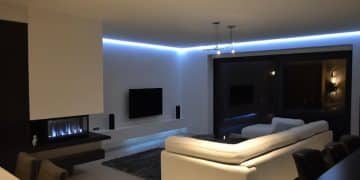Smart Climate Control: Optimize Your Home for Comfort & Savings

Smart climate control offers homeowners in the US the ability to optimize their home’s temperature, leading to increased comfort, reduced energy consumption, and significant savings on utility bills by leveraging automated systems and smart technology.
Are you tired of constantly adjusting your thermostat? Do you want to save money on your energy bills while maintaining a comfortable home environment? Smart climate control offers a solution, allowing you to optimize your home’s temperature for both comfort and savings. Let’s explore how it works.
Understanding Smart Climate Control Systems
At its core, a smart climate control system is designed to automate and optimize your home’s heating and cooling. These systems go beyond traditional thermostats, offering features like remote control, learning capabilities, and integration with other smart home devices.
By understanding the components and functionalities of these systems, you can make informed decisions about which type of smart climate control is best suited for your needs.
Key Components of Smart Climate Control
Smart climate control systems typically consist of several key components working in harmony to regulate your home’s temperature.
- Smart Thermostats: These are the brains of the operation, allowing you to set schedules, control temperature remotely, and learn your preferences.
- Sensors: Placed throughout your home, sensors monitor temperature and occupancy, providing data to optimize heating and cooling in different zones.
- Mobile Apps: Most systems offer a mobile app, allowing you to control your thermostat from anywhere and receive alerts about temperature changes.
- Smart Vents: These vents can be controlled remotely to direct airflow, allowing you to heat or cool specific rooms more efficiently.
These components work together to create a personalized and efficient climate control system, adapting to your lifestyle and minimizing energy waste.

Benefits of Switching to Smart Climate Control
Upgrading to a smart climate control system can offer numerous benefits beyond just setting the temperature. From cost savings to enhanced comfort and environmental impact, the advantages are compelling.
Let’s explore the key benefits that make smart climate control a worthwhile investment for US homeowners.
Cost Savings
One of the most significant benefits of smart climate control is the potential for cost savings. By optimizing heating and cooling schedules and reducing energy waste, these systems can significantly lower your utility bills.
Smart thermostats can learn your habits and automatically adjust the temperature when you’re away, preventing unnecessary energy consumption. Furthermore, features like zone control allow you to heat or cool only the rooms you’re using, further reducing waste.
Enhanced Comfort
Beyond cost savings, smart climate control enhances the comfort of your home. With precise temperature control and automated adjustments, you can maintain a consistently comfortable environment throughout the day and night.
- Consistent Temperature: Smart thermostats maintain a consistent temperature, eliminating temperature fluctuations that can cause discomfort.
- Personalized Settings: You can create personalized temperature profiles for different times of the day and different family members.
- Remote Control: Adjust the temperature remotely, ensuring your home is comfortable when you arrive.
These features allow you to create a tailored climate control experience that meets your specific needs and preferences.
Environmental Impact
By reducing energy consumption, smart climate control systems contribute to a smaller carbon footprint. Reducing the amount of energy used to heat and cool your home helps conserve resources and mitigate climate change.
Smart thermostats often provide insights into your energy usage, allowing you to identify areas where you can further reduce consumption. By making informed decisions about your heating and cooling habits, you can contribute to a more sustainable future.
Selecting the Right Smart Thermostat for Your Home
Choosing the right smart thermostat depends on your specific needs, budget, and compatibility with your existing HVAC system. Different models offer varying features and functionalities.
Consider these factors when selecting a smart thermostat to ensure it meets your requirements and delivers optimal performance.
Compatibility
Before purchasing a smart thermostat, ensure that it’s compatible with your home’s heating and cooling system. Some thermostats are designed for specific types of systems, while others are more versatile.
Check the thermostat’s specifications and compatibility requirements to avoid compatibility issues. If you’re unsure, consult a professional HVAC technician for assistance.
Features
Consider the features that are most important to you. Some smart thermostats offer advanced features like geofencing, voice control, and integration with other smart home devices.
Geofencing allows the thermostat to automatically adjust the temperature based on your location, while voice control enables hands-free operation. Integration with other smart home devices allows you to create a connected ecosystem for seamless control.
Budget
Smart thermostats range in price from relatively affordable to quite expensive. Determine your budget and compare different models within your price range.
While more expensive models may offer more features, there are plenty of affordable options that provide essential smart climate control functionalities. Consider the long-term cost savings when making your decision.

Installation and Setup Tips
Installing a smart thermostat is a straightforward process for many homeowners, but proper setup is crucial to ensure optimal performance and accuracy.
Follow these tips to ensure a smooth installation and setup process, allowing you to maximize the benefits of your new smart climate control system.
Read the Instructions
Before you begin, carefully read the manufacturer’s instructions. The instructions provide step-by-step guidance on how to install the thermostat properly and configure its settings.
Pay close attention to safety precautions and wiring diagrams to avoid damaging the thermostat or your home’s electrical system.
Proper Placement
The location of your smart thermostat can impact its accuracy and effectiveness. Avoid placing it in direct sunlight, near drafts, or in areas with poor airflow.
- Avoid Direct Sunlight: Sunlight can artificially inflate the temperature reading, causing the thermostat to undercool.
- Avoid Drafts: Drafts can cause the thermostat to overcorrect, leading to inconsistent temperatures.
- Ensure Good Airflow: Proper airflow allows the thermostat to accurately measure the ambient temperature.
Choose a location that is representative of the overall temperature in your home.
Calibration
After installation, calibrate your smart thermostat to ensure accurate temperature readings. Many thermostats offer a calibration feature that allows you to adjust the temperature offset.
Use a reliable thermometer to compare the thermostat’s reading with the actual temperature in the room. Adjust the calibration setting accordingly to improve accuracy.
Integrating Smart Climate Control with Other Smart Home Devices
One of the most exciting aspects of smart climate control is its ability to integrate with other smart home devices. This integration allows you to create a seamless and automated home environment.
Explore the possibilities of integrating your smart thermostat with other devices to unlock new levels of convenience and efficiency.
Smart Lighting
Integrate your smart thermostat with smart lighting to create a cohesive ambiance in your home. For example, you can program your lights to dim when the temperature reaches a certain level, creating a cozy and relaxing atmosphere.
This integration can also save energy by automatically turning off lights when a room is unoccupied, further reducing your carbon footprint.
Smart Security Systems
Connect your smart thermostat with your smart security system to enhance your home’s security and convenience. For example, you can program your thermostat to adjust the temperature when your security system is armed, ensuring efficient energy usage when you’re away.
Some security systems also offer integration with occupancy sensors, allowing your thermostat to automatically adjust the temperature based on whether or not someone is home.
Voice Assistants
Integrate your smart thermostat with voice assistants like Amazon Alexa or Google Assistant to control your home’s temperature with voice commands. This integration allows for hands-free operation and seamless integration with your existing smart home ecosystem.
Simply say “Alexa, set the thermostat to 72 degrees” to adjust the temperature without lifting a finger. This level of convenience makes smart climate control even more appealing.
Troubleshooting Common Issues
While smart climate control systems are generally reliable, occasional issues may arise. Knowing how to troubleshoot common problems can help you resolve them quickly and efficiently.
Here are some common issues and their solutions to help you keep your smart climate control system running smoothly.
Thermostat Not Connecting to Wi-Fi
One common issue is the thermostat’s inability to connect to your home’s Wi-Fi network. This can be caused by a weak Wi-Fi signal, incorrect password, or compatibility issues.
- Check Wi-Fi Signal: Ensure that your thermostat is within range of your Wi-Fi router and that the signal strength is strong.
- Verify Password: Double-check that you’ve entered the correct Wi-Fi password.
- Reboot Router: Sometimes, simply rebooting your Wi-Fi router can resolve connectivity issues.
If the problem persists, consult the thermostat’s manual or contact customer support for assistance.
Inaccurate Temperature Readings
Inaccurate temperature readings can cause your thermostat to undercool or overheat your home. This can be caused by improper placement, calibration issues, or faulty sensors.
Ensure that your thermostat is placed in an optimal location and calibrate it according to the manufacturer’s instructions. If the problem persists, the sensors may be faulty and need to be replaced.
Scheduling Issues
Scheduling issues can prevent your thermostat from following your programmed schedules, leading to inconsistent temperatures and wasted energy.
Double-check your schedules to ensure they are programmed correctly and that there are no conflicts or overlapping settings. If the problem persists, try resetting the thermostat to its factory settings and reprogramming the schedules.
| Key Feature | Brief Description |
|---|---|
| 💡 Energy Savings | Reduces energy consumption by optimizing heating and cooling schedules. |
| 🌡️ Temperature Control | Maintains consistent temperature for enhanced home comfort. |
| 📱 Remote Access | Allows control of the thermostat from anywhere via a mobile app. |
| 🏡 Smart Integration | Connects with other smart devices for a seamless home automation experience. |
What is Smart Climate Control?
Smart climate control systems allow you to remotely manage your home’s temperature settings and program individualized settings for different days and times.
Is It Expensive To Install Smart Climate Control Systems
The cost to instal smart climate control systems varies, depending on the type of system you choose as well as the installation service. However, the savings you get from the smart climate control could very well pay for the initial expense.
What Are The Benefits of Smart Climate Control?
Smart climate control brings many advantages, including the ability to save energy, lower your heating and cooling costs, remote temperature control, and optimized comfort.
▼
Smart climate control systems use features like occupancy sensors and learning algorithms to optimize heating and cooling schedules, reducing energy waste by automatically adjusting temperatures when no one is home or during periods of low activity.
▼
Yes, most smart thermostats come with mobile apps that allow you to control your home’s temperature from anywhere with an internet connection, providing you with convenient remote access and management.
▼
Smart climate control systems are designed to be compatible with most HVAC systems, but it is important to check the specifications of your chosen thermostat to ensure it is compatible with your specific heating and cooling setup.
▼
Smart climate control systems enhance comfort by maintaining consistent temperatures, allowing you to set personalized temperature profiles, and utilizing features like zone control to heat or cool specific rooms according to your needs.
▼
Many homeowners can install a smart thermostat themselves by following the installation manual. If you aren’t comfortable doing this you will have to hire a professional to complete the installation for you.
Conclusion
Smart climate control is an innovative way for every home to regulate the temperature. With all of the methods detailed in the above article, any homeowner can enjoy the benefits of implementing smart climate control in their home.





